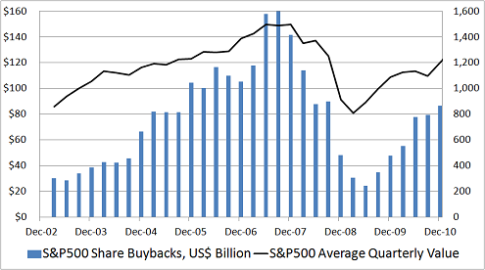Staples: Compounding or Destroying Value?
I'm highly skeptical about the economic value of most share repurchase programs. To see why, look at the following graph of the total buyback dollar amount for the companies in the S&P 500, compared to the average price of the index on a quarterly basis:

Source: Capital IQ, a division of Standard & Poor's.
Share buybacks for the S&P 500 accelerated in the second half of 2004, culminating in a sharp spike during the first two quarters of 2007 -- just as the stock market was peaking. Conversely, when stocks traded at bargain prices during the worst of the crisis, share buybacks dried up. Then, as stocks became more expensive during the rally that began in March 2009, companies once more became happy to step up the dollar amounts spent on share repurchases.
Still, not all buyback programs hurt shareholders. In order to praise smart capital allocators and shame those who fritter away shareholder capital, I've decided to evaluate individual share repurchase programs. Today, I'm looking at the new program established by office products supplier Staples (NAS: SPLS) .
How much, for how long?
The new $1.5 billion share buyback authorization replaces the $295 million left over from prior buyback programs. The company has placed no other restrictions on when it will buy shares, or in what amounts.
How cheap is the stock?
Staples' buyback announcement doesn't specifically mention the share price as one of factors that will determine their ability to spend their authorization. That's a shame because the relationship between price paid and intrinsic value will determine whether the share repurchases are compounding or destroying shareholder wealth. Just how cheap (or expensive) are Staples shares right now? Based on its price-to-earnings ratio, Staples trades at the lower end of the range among its retailing peer group:
Company | Forward P/E |
|---|---|
Office Depot (NYS: ODP) | 46.3 |
Bed Bath & Beyond | 14.5 |
The Home Depot (NYS: HD) | 13.4 |
Staples | 9.1 |
OfficeMax (NYS: OMX) | 7.2 |
Source: Capital IQ, a division of Standard & Poor's.
Is this a smart use of shareholder capital?
Staples' price-to-earnings multiple currently lies in the bottom half of the range of the company's industry peers or the S&P 500, and in the bottom quintile with respect to its own five-year history. With shares trading at just 9.1 times its earnings-per-share estimate for the next 12 months, Staples' share buyback program looks like a very good use of shareholder capital. In fact, I think it's worth adding Staples to your watchlist.
Companies can't misallocate the cash they return to shareholders. The Motley Fool's best analysts have identified great companies that let you decide how to spend your profits in our special free report, "13 High-Yielding Stocks to Buy Today."
At the time thisarticle was published Fool contributorAlex Dumortierholds no position in any company mentioned.Click hereto see his holdings and a short bio. You can follow himon Twitter.Motley Fool newsletter serviceshave recommended buying shares of Bed Bath & Beyond, Staples, and The Home Depot. Try any of our Foolish newsletter servicesfree for 30 days. We Fools may not all hold the same opinions, but we all believe thatconsidering a diverse range of insightsmakes us better investors. The Motley Fool has adisclosure policy.
Copyright © 1995 - 2011 The Motley Fool, LLC. All rights reserved. The Motley Fool has a disclosure policy.

